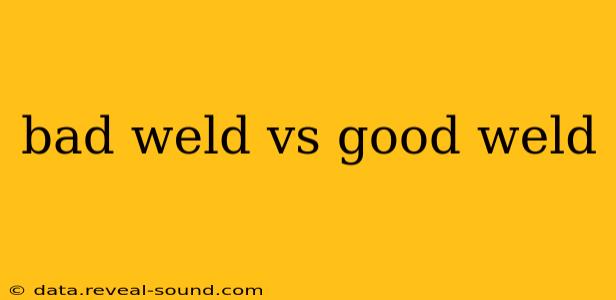Welding is a crucial process in numerous industries, from construction and manufacturing to automotive and aerospace. A strong, reliable weld is paramount for safety and structural integrity. However, a bad weld can have devastating consequences, leading to catastrophic failures and costly repairs. This guide will explore the key differences between a good weld and a bad weld, enabling you to better understand weld quality and identify potential problems.
What Makes a Good Weld?
A good weld is characterized by several key features:
- Complete Penetration: The weld must fully fuse the base materials, creating a complete joint. Incomplete penetration leaves areas of weakness, significantly reducing strength.
- Consistent Bead Shape: The weld bead should have a uniform appearance, indicating consistent heat input and proper welding technique. Irregularities can signal problems with the process.
- Absence of Defects: A good weld is free from porosity (small holes), cracks, inclusions (foreign material), and undercut (a groove at the weld toe). These defects compromise strength and can initiate failure.
- Proper Fusion: The weld metal must properly fuse with the base metal, creating a strong metallurgical bond. Lack of fusion creates a weak point prone to fracture.
- Correct Size and Dimensions: The weld should meet the specified dimensions outlined in the welding procedure specification (WPS). Incorrect dimensions can affect the structural integrity of the joint.
- Sound Mechanical Properties: A good weld will possess the required mechanical properties (tensile strength, ductility, etc.) as defined by the relevant standards and specifications.
What Constitutes a Bad Weld?
A bad weld exhibits one or more of the following characteristics:
- Incomplete Penetration: This is a major defect where the weld doesn't fully penetrate the base materials, creating a weak point.
- Porosity: Small gas pockets within the weld metal reduce strength and create stress concentration points.
- Cracks: These are fractures within the weld metal or the heat-affected zone (HAZ), significantly weakening the joint.
- Undercut: A groove at the edge of the weld, reducing the weld's effective cross-sectional area and weakening the joint.
- Inclusions: Foreign material embedded in the weld, such as slag or tungsten inclusions (in tungsten inert gas welding), lowering strength and ductility.
- Lack of Fusion: The weld metal doesn't properly fuse with the base material, resulting in a weak, discontinuous bond.
- Excessive Spatter: Excessive spatter indicates inconsistent welding parameters or poor technique, and may also create areas of porosity.
- Incorrect Bead Profile: An uneven or irregular bead profile indicates inconsistent welding parameters or improper technique.
How to Identify a Bad Weld?
Identifying a bad weld often requires a combination of visual inspection and non-destructive testing (NDT) methods.
- Visual Inspection: This is the first step and involves carefully examining the weld for obvious defects like cracks, porosity, undercutting, and lack of fusion.
- Non-Destructive Testing (NDT): Methods like radiographic testing (RT), ultrasonic testing (UT), and magnetic particle testing (MT) are employed to detect internal flaws not visible to the naked eye.
What are the consequences of a bad weld?
The consequences of a bad weld can range from minor inconvenience to catastrophic failure, depending on the application. In critical applications like bridges, pressure vessels, and aircraft components, a bad weld can have life-threatening consequences. Even in less critical applications, a bad weld can lead to costly repairs, downtime, and product failure.
How to Prevent Bad Welds?
Preventing bad welds involves a multi-pronged approach focusing on:
- Proper Welding Technique: A skilled welder is crucial. Consistent welding technique is key to producing high-quality welds.
- Appropriate Welding Parameters: Using the correct welding parameters (voltage, current, travel speed, etc.) as specified in the WPS is essential.
- Cleanliness of Base Material: Clean base materials are crucial for good weld penetration and fusion.
- Proper Joint Design: A well-designed joint is easier to weld and less prone to defects.
- Regular Inspection and Quality Control: Regular inspections and quality control measures throughout the welding process are vital to identifying and rectifying defects early on.
What are the different types of weld defects?
Weld defects can be broadly classified into several categories, including:
- Surface Defects: These are visible on the weld surface, such as undercutting, overlaps, cracks, and spatter.
- Internal Defects: These are not visible to the naked eye and require NDT methods for detection, such as porosity, inclusions, lack of fusion, and incomplete penetration.
- Geometric Defects: These involve deviations from the specified dimensions or shape of the weld.
Understanding the differences between good and bad welds is paramount for ensuring safety, reliability, and structural integrity. By employing proper welding techniques, adhering to established standards, and implementing robust quality control measures, we can minimize the risk of weld defects and ensure the success of our projects.
